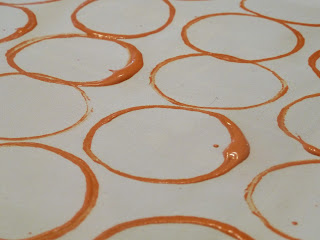We eat a lot of fermented milk products in our house. My kids LOVE yogurt, sour cream, and cheese. But yogurt is crazy spendy if you eat as much as we do, so I most often make it. It's really easy! Granted, it requires a good bit of attention at the beginning of the process, and it's really disappointing when you wait for a gallon of milk to ferment and something goes wrong. But after you've made your own yogurt a few times you get a good feel for what works, what doesn't, and how much attention you really need to pay to it.
You don't need any fancy yogurt makers or other special equipment. A heating pad, like one you'd get for sore muscles, is handy, but if you can do without your oven for 6-8 hours that'll work just as well.
So, what you do need is a pot big enough to hold the milk, a whisk, a spatula, and a candy thermometer. You could get by with a meat thermometer too, actually, but the candy thermometer will clip to the side of your pot, and that's really handy. You also need the milk and a yogurt starter. We like to use whole milk, because it's more filling, richer, and makes a thicker yogurt. You'll need to make sure that the yogurt you buy has live active cultures in it, and that it's one you like. Your homemade yogurt is going to have the same flavor and texture as you starter, so you don't want to waste your time making yogurt from one you won't even eat. Our favorite is Nancy's, partly because it's local for us, but I know others use Dannon, or even some types of Greek yogurt. Just read the ingredients; it'll say live active cultures on it, or it'll have a list of crazy Latin sounding names at the end.
The yogurt I'm using this time is Nancy's vanilla. I recommend using either plain or vanilla yogurt, so that you can flavor it however you want later.
First you want to sanitize your pot. I just put an inch or so of water in it, toss in my whisk, spatula, and thermometer, and boil for 5 minutes or so. I put the lid on top (even though everything sticks out) to help hold the steam in.
When that's done, dump out the water and pour in the milk. Set it back on the stove, this time on medium low heat. You want to get the milk up to 185F, but do so slowly. Heating it too fast will make it cook and stick on the bottom, and your yogurt will end up with a cooked milk flavor. You don't have to stir it constantly, but give it a good whisk every few minutes to keep it from cooking on the bottom.

While it's heating, make sure your sink is empty and at least mostly clean. Maybe do the dishes while it's getting hot. I don't know, do whatever you need to do. :D Once your milk is 185F, you want to cool it down quickly. I put in a sinkfull of water with a bunch of ice. Stir it while it cools, so you get an accurate reading. Get your yogurt out of the fridge and let it warm up a bit while your milk is cooling off. When it's right about 120F is when you add your yogurt. If you dip your pinkie in it should feel like a nice warm bath, not hot. Definitely hotter than a baby bottle should be.
Pour a bit of the warm milk into the yogurt and whisk it up. This makes it easier to mix the yogurt into the whole thing.
Whisk that well, get it nice and uniform. Then pour it back into the warm milk.
 |
| Hey, counter, your 1970's is showing. |
Slap a lid on that puppy and leave it somewhere to warm. I set it on top of a heating pad like thus:
and wrap it in a towel:
Leave it there for 6-8 hours, until it smells like delicious yogurt and is thickened. You can also put it in your turned-off oven, and just leave the light on. That'll keep it at just about the right temperature for yogurt. Don't forget to turn your heating pad off and back on every couple hours or so if you have one like mine that automatically turns off. That's why I normally opt for the oven method, but I needed my oven today so heating pad it is!
You may notice I didn't give any measurements. That was intentional. The measurements aren't super important. This time I happened to use 1/2 gallon of milk and about 1/2 cup of yogurt. You can easily make a whole gallon of yogurt if you eat a lot (we normally do), or make just a quart. You want to have at least 1/4 cup of yogurt no matter how much milk you use, but the precise amount isn't critically important.





































